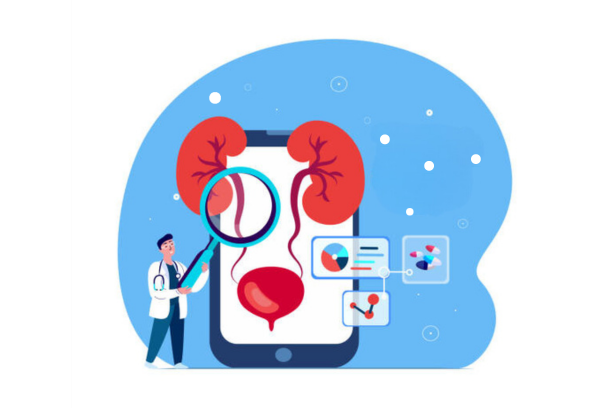In critical care nephrology, remote kidney monitoring is bridging the gap between hospital-based intensive care and post-discharge patient management. This approach enhances how acute kidney injury (AKI) cases are handled both during hospitalization and in the crucial weeks following discharge.
In this article, we’ll explore remote kidney monitoring in critical care settings and how it aids in the management of acute kidney injury (AKI). We examine how this technology is being applied both within intensive care units and in post-discharge care for AKI survivors.
Drawing from recent research, we’ll discuss:
- The implementation of remote monitoring in ICUs for early AKI detection
- A pioneering post-discharge remote monitoring program for AKI survivors
- The outcomes of the research
- Challenges and future prospects for remote kidney monitoring
- The broader implications for critical care nephrology
The first study we discuss outlines a remote kidney monitoring program to enhance post-hospitalization for AKI.
Remote Kidney Monitoring in Critical Care
Acute kidney injury often affects hospitalized patients, associated with adverse outcomes and inadequate follow-up care. To address this gap, a remote kidney monitoring program was developed and implemented at a renowned medical center to improve the post-hospitalization care of AKI survivors.
Digital health solutions were used in the research to monitor and manage AKI survivors after discharge. Patients eligible for the program experienced stage 2 or 3 AKI and underwent nephrology consultations during their hospital stay.
Patients used remote kidney monitoring devices, including blood pressure, weight, pulse oximetry, and other remote patient monitoring devices. Weekly laboratory assessments were conducted, and remote patient monitoring nurses evaluated the data daily. Escalation protocols were developed while weekly calls ensured close patient follow-up. Patients were monitored remotely for at least four weeks and up to 90 days post-discharge.
During the program’s first five months, 20 patients were enrolled with a median participation duration of 36 days. Of the enrolled patients, 40% experienced unplanned readmissions or emergency department visits, with half of these cases related to AKI. A survey revealed high patient satisfaction, with 89% indicating they would recommend remote patient monitoring to others with similar health conditions.
Challenges
While the AKI remote kidney monitoring program showcased promising results, some limitations were identified. There needs to be more resources in other settings to allow its scalability and generalizability. Additionally, the program was tested primarily among non-Hispanic Caucasian patients, suggesting the need for further diversity in testing and expansion.
In the second research article researchers discuss the nephrologists’ role in critical care: early AKI detection, renal replacement therapy, and multidisciplinary collaboration. Both research summaries underscore how remote patient monitoring (RPM) and critical care nephrology can improve acute kidney care challenges.
Critical Care Nephrology in the ICU and Kidney Monitoring
Critical care nephrology is at the forefront of managing acute kidney injury AKI and renal complications in critically ill patients. Critical care nephrologists are pivotal in optimizing patient outcomes in intensive care units (ICUs). Due to stressors like sepsis and surgeries, early detection and management of kidney monitoring are vital to survival.
One of the primary responsibilities of critical care nephrologists is the early identification of AKI. Close kidney monitoring of renal function and utilizing emerging biomarkers and dynamic clinical decision support systems work in tandem for timely care.
Critical care nephrologists work with intensivists, surgeons, nurses, and more, contributing to comprehensive patient care. Their insights on kidney monitoring, renal management, medication adjustments, and fluid balance optimization ensure a holistic approach to ICU care.
Despite advancements, challenges such as resource limitations and shortages of trained nephrologists persist. Therefore, increasing awareness and investing in education and training programs are essential. This is why technological integration, including telemedicine and remote kidney monitoring with AI-driven support systems, holds promise in addressing challenges and expanding access to critical care nephrology services.
Promoting education and harnessing technologies in telemedicine and remote patient monitoring for kidney monitoring are all vital to ensuring that critically ill patients receive the highest standard of care. Moreover, telemedicine technology can help bridge the gap in access to specialized care, particularly in underserved regions.
Understanding Remote Kidney Monitoring
In summary, these studies show the advances remote kidney monitoring and remote patient monitoring are making in critical care nephrology to improve care for AKI survivors and critically ill patients.
Scroll down now to subscribe to Tenovi’s Weekly Research Round-Up. With Tenovi, healthcare providers can access billing, device management, fulfillment, and API integration dashboards. Schedule your free demo and consultation with us today.


